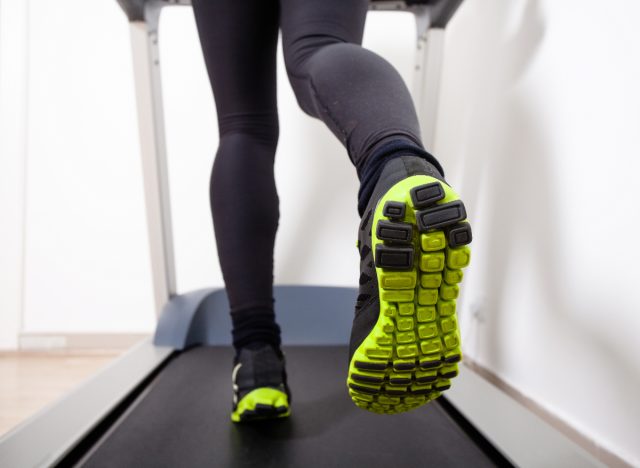Have a seat; it can prove to be healthy! Sitting in a chair might do more to lower your blood sugar and avoid type 2 diabetes than going for a walk or a run. By performing a special type of exercise using a muscle in your lower leg, you can boost your metabolic health, says University of Houston professor of Health and Human Performance, Marc Hamilton, Ph.D. Are you intrigued? If so, keep reading to learn more about this simple sitting exercise that can lower blood sugar and burn fat.
Don’t expect to break a sweat—the “soleus pushup” is performed while sitting.


A recent study published in the journal iScience suggests that this particular leg exercise improves blood sugar regulation better than traditional methods. This includes weight loss, diet, and the 30-minutes of low- to moderate-intensity daily exercise recommended for lowering the risk of developing type 2 diabetes. Hamilton calls the metabolism-boosting technique the “soleus pushup,” but don’t expect to break a sweat while doing it. You actually perform this “pushup” while sitting. And that’s the beauty of the exercise! Americans spend 10 hours a day sitting down on average, according to the University of Houston, while they may spend only a small fraction of their waking hours being physically active.
Related: The #1 Strength Workout To Regain Muscle Mass as You Age, Trainer Says
The soleus muscle plays a key role in walking, running, and standing.


The soleus muscle is situated on the back of the lower part of your leg. This strong muscle plays a role in walking and running, according to Verywell Health, but its greatest task is keeping you from falling forward while standing. Unlike most muscles that use stored carbohydrates for fuel, the soleus doesn’t rely completely on intramuscular glycogen. Instead, it uses a mixture of fuels from the blood, namely, glucose and blood fats called lipoproteins. As Hamilton puts it in a report from the University of Houston, “When activated correctly, the soleus muscle can raise local oxidative metabolism to high levels for hours, not just minutes, and does so by using a different fuel mixture.”
The University of Houston researchers tested sedentary participants who performed the soleus pushup after ingesting a glucose drink. Hamilton’s experiments suggest that people can decrease their blood glucose by about 52% with a single session of soleus muscle contractions. The study also shows that the exercise reduced the amount of insulin released by the pancreas by 60%.
“The magnitude rivals what you would see in the hours after exercise or any other type of therapy,” Hamilton reveals in a University of Houston video. “We don’t know of any therapeutic approach, even the strongest pharmaceuticals, that comes close to raising metabolic rate as much as activating 1% of your body’s weight through sustained soleus contractions.”
READ RELATED: America's Favorite Fast-Casual Chain Is Cheaper Than Similar Competitors, Survey Shows
Additionally, the study found that keeping the soleus muscle activated was effective at doubling the typical rate of fat metabolism, reducing levels of triglycerides in the blood.
Here’s how you can do the soleus pushup.
Sit in a chair with your feet flat on the floor and your body relaxed. Keeping the front of your foot on the floor, raise your heels to their full range of motion. Release to allow your heels to return to the floor. And repeat.
Before you start doing heel raises at your work desk, there’s a caveat. “The soleus pushup looks simple from the outside, but sometimes what we see with our naked eye isn’t the whole story. It’s a very specific movement that right now requires wearable technology and experience to optimize the health benefits,” explains Hamilton.
The researchers are working on guides to teach the proper technique without the use of specialized equipment. Meanwhile, Hamilton hopes his research will call attention to the overlooked potential of targeting small, highly oxidative muscles with contractions as a method for improving blood sugar control in a sedentary population.
“It’s much like we’ve discovered a new organ,” Hamilton says in the video. “Even though it’s there, we’ve seen it, but we didn’t know how to use it correctly to optimize our health.”
Jeff Csatari
editing Galvanized Media books and magazines and for advising journalism
students through the Zinczenko New Media Center at Moravian University in Bethlehem, PA. Read more about Jeff
Source:








